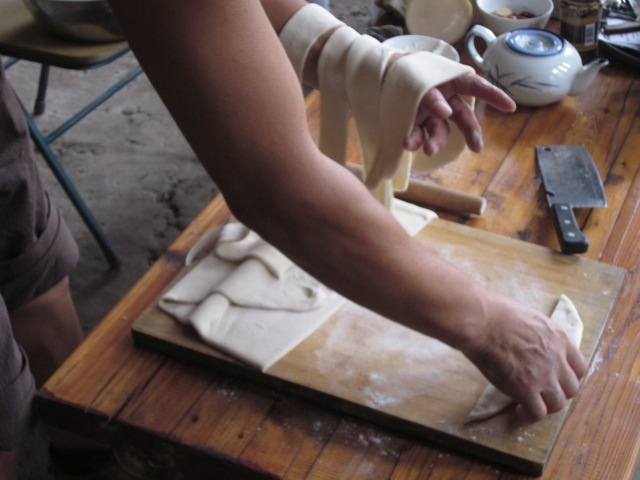On July 13th, 2011 the entire field school team made their first visit to Mr. Her’s studio. Mr. Her showed the team around his studio, which is currently under construction. He discussed with us several of his finished paintings. The paintings were lined up under a covered walkway with an open wall to a courtyard. He is originally from Su Pu village in Southern Ningxia Hui Autonmous District in North Central China. He explained the strong influence his home has on the imagery in his paintings. Mr. Her also described the materials he used, where he obtained the materials in Song Zhuang and how his canvases were constructed. There are several stores in Song Zhuang where artist’s materials are sold since there are so many working artists in the area.
Mr. Her told us he was working very closely with the workers helping him build the studio to make sure it fit his specific vision. He wanted to make sure his studio and gallery space would be the best space for presenting his artwork in. For example, the courtyard has hand carved images of oxen in the stone walls that Mr. Her created. His studio is still under construction and is representative of many studios in the area with regard to its state of completion. During the course of this first tour, Mr. Her told the team he would make the fieldwork team noodles the following day.
When the team returned to his studio the following day Mr. Her had already prepared the dough and it was ready to be kneaded. The team documented the preparations of the noodles from this point on. Mr. Her described the process of making the dough. He woke up at six in the morning (he was making lunch for us) and began preparing the dough which would eventually be the noodles. He told us it was important to let the dough sit for one to two hours before kneading it so it would reach the right consistency. During the morning he had also obtained the other ingredients of the soup, including vegetables and meat, and beer for the lunch.
Throughout the noodle preparation, the sound of construction could be heard in all four directions around Mr. Her’s studio. In the courtyard you could clearly hear the sounds of drilling, construction materials being moved at the sites of nearby studios and buildings. You could also hear vehicles and trucks moving down the streets around the studio. If you listen to the audio recording of the noodle preparation below can you pick out these sounds? What other sounds can you hear? The sounds of construction could also be heard in the partially enclosed area in Mr. Her’s studio where the noodles were being made, since he was still in the process of installing doors and walls. The partially enclosed area where he prepared the noodles had a second floor above it. It was still under construction and would eventually become a gallery to show his finished work to visitors.
While Mr. Her was making the noodles the materials he had out on the work table included cutting boards with flour, a teapot, ladle, chopsticks, knives, rolling pins, a lazy susan with tea and condiments, two rags, a bowl of flour and a half chopped potato. He used a table about two feet above the ground to knead, roll and cut the dough. The table was in the center of the partially constructed room and the stove was to the side of the table. Since the table was in the center of the room it was easy for the fieldwork team to document the process. Mr. Her kneaded the dough and showed one member of our team, Jeanette, how the knead the dough using the technique he was using. Jeanette received feedback from the fieldwork team and Mr. Her about how to best knead the dough to create the proper texture of the noodles. After several minutes Mr. Her began to knead the dough again.
The whole team formed a semi-circle around Mr. He while he was kneading and cutting the noodles in order to document the process. His wife videotaped and photographed the group gathered around Mr. Her. Neighboring artists, including Mr. SouTian, also came in towards the end of the preparation and ate lunch with the fieldwork team. When Mr. Her moved to the pot of boiling vegetables and meat in order to put the noodles in, the whole team moved with him to follow the process of putting the noodles in to the pot. After documenting the process of preparing the noodles, the fieldwork team had lunch with Mr. Her and some of the artists with studios neighboring his.
[vimeo]http://vimeo.com/31348440[/vimeo]
When you watch the video and look at the photo gallery, what kitchen utensils are like the ones you would use to prepare noodles, pasta or another similar dish? Do you think you could recreate the technique used to make these noodles after watching this video?
Listen to the sound recordings below. What sounds can you pick out from the background of the recording of noodle preparation and the recording of the fieldwork team having lunch?
Mr. Her explains his process while he prepares noodles by chinavine



















